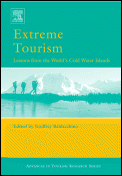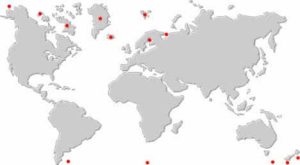Extreme Tourism in ‘Cold Water’ Islands

Extreme Tourism in ‘Cold Water’ Islands
Edited by Godfrey Baldacchino
2006 | Elsevier Science, ‘Advances in Tourism Research’ Series
Available from Routledge
- CONTENTS: Section I – Introduction and an Addressing of Conceptual Themes
- CONTENTS: Section II – Specific Case Studies of Tourism in Cold Water Islands
Map of islands discussed in the book:

RATIONALE
The image of tourist destinations as alluring undiscovered paradises has much to do with islands. But these images or tropes are based on one crucial premise – warm climates. But Nature is not always seen as benign: indeed, nature may appear as the principal, insurmountable enemy to a tourism industry.
As one moves away from the tropical through the temperate to the frigid regions of the globe, the paradise myth as tourist package is harder, and eventually simply impossible, to justify. Or is it? And if we have been socialized into expecting islands to be malleable, erotic, exotic – as represented in Shakespeare’s The Tempest, Defoe’s Robinson Crusoe,Swift’s Gulliver’s Travels, Swiss Family Robinson, Verne’s Mysterious Island (as texts) Blue Lagoon, Live and Let Die, Castaway (as films), and Big Brother (as TV serial) – what is the cold water equivalent of such islands? Or is this characterization still waiting to be invented?
KEY QUESTIONS
Tourism is a space-time phenomenon. It concerns activities and experiences entered into at specific locations and for specific time-periods. Cold water islandness is bound to affect both these variables. In what way? With what implications to the tourism industry?
The key, research interrogatives which will drive this book forward include the following themes. These will be the questions to be addressed by the authors writing each specific island case study:
Understanding the Allure – In spite of the voluminous text that has been written about the subject, understanding what is the island lure, or what is it exactly that attracts visitors to islands and ‘islandness’, remains speculative.. The physical remove from the mainland, necessitating a conscious decision to cross the water, the chance to get away from it all in a slower-paced environment, and the ability to seek to take in the totality of a destination are presented as three explanations for the inherently distinct adventurism of a trip to an island, especially a small island. How do islands on the extremities of the Earth’s geography and climate seek to promote themselves as tourism destinations, and develop a tourism product? The myth/imagery of the island as paradise has been a powerful one; so has the discourse of the frontier. What happens when these images are combined? And is the result compatible with the type of tourism that is desirable and appropriate to the locality and its people?
Cold Weather Tourists – Prevailing weather conditions may be less significant features to visitors to cold water islands than to other locations, since most activities are not highly weather dependent and in some cases – such as angling and bird watching – may actually depend on adverse weather conditions. Small numbers of visitors with very special interests tend to be attracted. To what extent do ‘cold water tourists’ exist as a tourist ‘type’? And how do they differ, if at all, from their warm water cousins?
Remoteness as Boon or Bane – Given their extreme and insular location, and shorn of the paradise hype of sun, sand, sea (and sex?), islands on the top and bottom of the world can be seen as absolutely the most remote and foreboding destinations on the planet. Their appeal appears naturally limited with respect to the conventional mass market. The islanders themselves, of course, may beg to differ. Or would they? Is this condition actually a great advantage in (self-) regulating tourism flows and in preventing an often-irreversible route towards mass tourism and the serious erosion of fragile island ecosystems that so many other destinations have gone for, by design or default? After all, while the locals may lobby to improve access, such measures may well remove the greatest asset that an island may have in managing the quantity, type and extent of tourism development. Their appeal may relate to the very real sense of aloofness and difference, caused in part to they being physically separate, and perhaps therefore different from adjoining mainlands. Jurisdictional specificity (such as being a sovereign state or being a province) can be expected to enhance such a condition of differentiation and, therefore, of intrinsic appeal.
Issues of Access – The idea of ‘distance decay’ suggests that the extent of spatial interaction is inversely related to distance. Now, access to islands is usually messy, complicated, expensive, hazardous, time-consuming, irregular and/or unreliable – leading to expectations of low tourism interest and presence. To what extent should access to islands be mitigated or changed? To what extent is this changing anyway, irrespective of human planning (for example, because of global warming)? What brand of economic development, what means of (air/land/sea) transportation and infrastructure (or mix thereof) lend themselves to a ‘wise’ tourism strategy? Or are such decisions taken with other concerns in mind, and tourism policy is only ‘muddled through’?
Volatility and Monopoly – Small islands are characterized by resource and market scarcity and intense openness. This suggests that changes brought about by an exogenous (external) variable such as tourism will be rapid, deep and intimate. Intense openness also means that a small island economy can quickly become dependent on the tourism industry with visitors from faraway, foreign lands and their often fickle tastes and erratic vagaries: a hazardous proposition. Moreover, the policies and practices of just one tour operator, one airline, perhaps one hotel, could make or break the tourism industry. Service providers in the industry, as with other industries on the cold water location, tend towards being oligopoly or monopoly providers. Is there such a volatility and boom-bust orientation in the tourism industry of cold water islands? Is there a tendency towards concentration of capital, skill or service? With what effects?
Global Tourism’s Final Frontier? – Specific tourist types are concerned with a search for the novel and the authentic. Islands, like frontier regions, have a particular appeal to those tourist types keen on natural environments, traditional cultures, unorthodox scenarios. If the tourism ‘area cycle’ evolutionary model generally holds, then the last ‘raw’ outposts of civilization to be discovered by the tourism industry could be assumed to be these cold water island locations that would most likely enjoy its latest – and final? – boom. As communities in destination regions face the downside of tourism, and as tourists become dismayed at the non-primitive and/or non-authentic character of the natives, the urge to seek out even more remote, genuine, pristine and extreme locations remains strong. It may be just a question of time before all corners of the world are fully integrated into a global tourism vice, as technology continues to make the world smaller and more accessible. But, it’s a big IF. What if a small, cold water island has a totally different competitive advantage which suggests its own evolutionary pattern? Can such locations develop their own response to the changing spatial patterns of global tourism? Is the ‘island as prison’ its greatest, ultimate asset?
Tourist-Resident Tensions – If this is the case, then relative inaccessibility, the absence of much development and the presence of few other tourists are aspects of the competitive tourism advantage enjoyed by cold water islands. But this also means that the scale and type of tourism and its development must be closely managed. This may be easier to do in frontier sites where land area is typically large and population levels minimal. In contrast, on small islands, land is finite and the contact between tourists and local residents is impossible to avoid, and potentially tense. Local residents may have needs which run counter to arguments about their own tourism industry’s sustainability; land use conflicts are also more likely.
Politics and the Urban Bias – A final comment concerns the political. Extreme island regions may lie on the political periphery, especially when they have small populations: un/under-represented in the corridors of power; largely forgotten by centralized policy makers suffering from ‘the urban bias’; dismissed as insignificant backwaters other than, perhaps, in strategic terms. These features may, in themselves, suggest a precarious status which attracts a bold tourist elite; but they may also bring about the haphazard and dependent development of a tourism industry which suffers from benign domestic neglect: with non-domestic tourist visitors being catered for by non-local businesses. The long-term consequences of such a condition may not be pleasant.